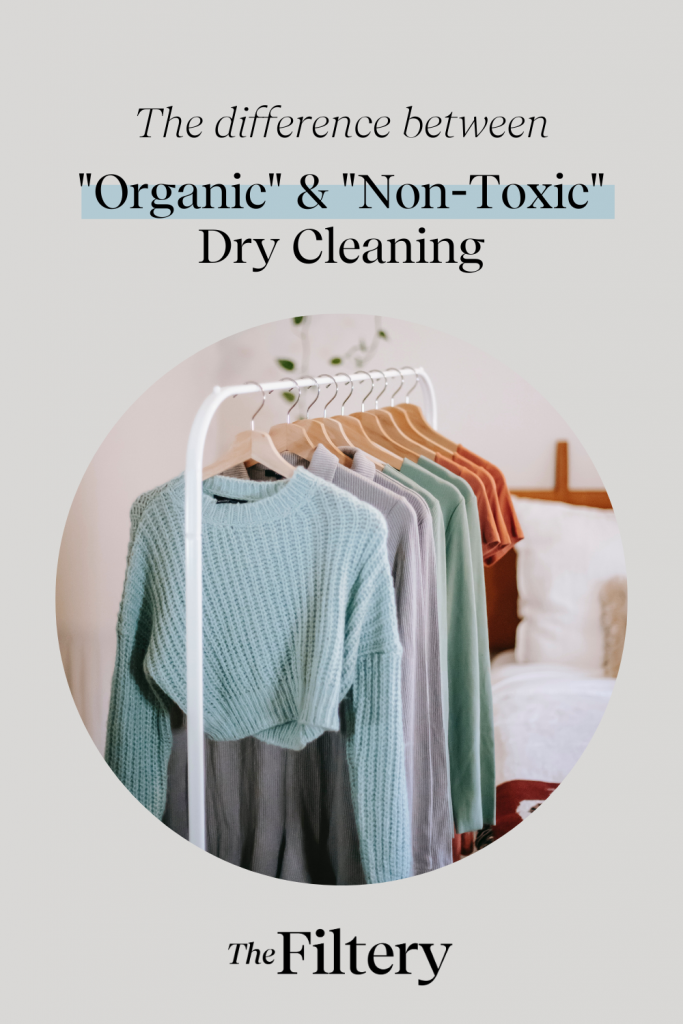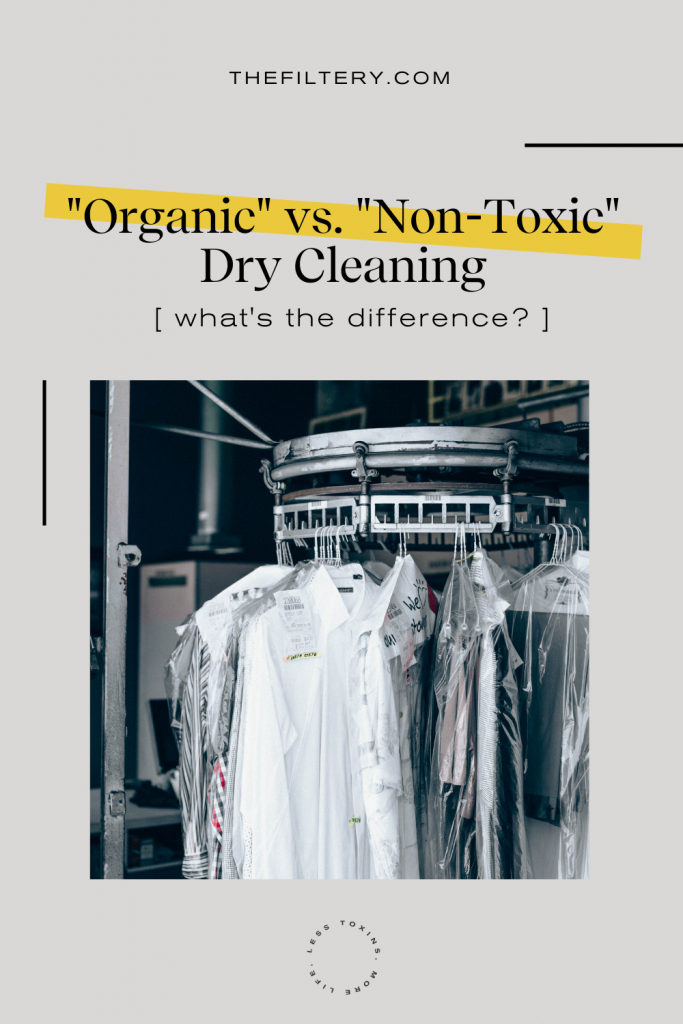The terms ‘organic’ and non-toxic’ are often used interchangeably, but when it comes to dry cleaning, the two can actually mean very different things.
When it comes to things like food and textiles made from natural materials like cotton, ‘organic’ means that the plant was grown and processed without toxic synthetic pesticides or fertilizers… But this is not the same with dry cleaning, where‘organic’ substances can actually be toxic.
Let’s clear this up so you can decide how you want to get your clothes cleaned.
Table of Contents
- Why Traditional Dry Cleaning Is Toxic? (& What Really is Organic Dry Cleaning?)
- Is Dry Cleaning Bad for the Environment?
- What is Non-Toxic/Green Dry Cleaning?
- So, what are the different types of safer dry cleaning options available?
- 1. Hydrocarbon Dry Cleaning (Better)
- 2. Liquid Carbon Dioxide (CO2) Dry Cleaning (Better)
- 3. GreenEarth® Dry Cleaning (Better)
- 4. Wet Cleaning (Best)
- What About “Natural” Dry Cleaning?
- How to Find Truly Non-Toxic & Organic Dry Cleaners Near You
- Other Dry Cleaning Alternatives
- TL;DR: Is Dry Cleaning Safe?
Why Traditional Dry Cleaning Is Toxic? (& What Really is Organic Dry Cleaning?)
Traditional dry cleaning is known to use a common toxin called perchloroethylene (also referred to as perc), which is a human carcinogen. Perc can get into the body either through inhalation or skin absorption. Prolonged exposure to perc can cause a number of health problems, from impaired cognitive function to cancer.
But what is noteworthy here is that perc is considered ‘organic.’ In this case, “organic” refers simply to any “compound that requires carbon.” Whether or not toxic chemicals are used is irrelevant.
For this reason, consumers should be wary of the organic signs in your dry cleaner’s window because that does not always mean the products are non-toxic. As there is no official certification process for ‘organic’ dry cleaners, understanding the difference between organic and non-toxic dry cleaning practices is key.
The majority of dry cleaners in the United States (around 60-65%) still use perc as their primary solvent, despite the United States Environmental Protection Agency (EPA) listing it as both a health and environmental hazard.
Since the 1990s, the EPA has taken a few steps to regulate the types of dry cleaning chemicals used and has been encouraging commercial cleaners to use more environmentally friendly detergents and solvents.
Back in 2007, the state of California approved a perc phase-out, which provided grants to dry cleaners to help them transition to an alternative method such as wet cleaning or CO2 cleaning. Due to these regulations, perc is no longer allowed to be used in dry cleaning operations in California as of January 1, 2023.
Minnesota is following suit and is set to have perc phased out by 2026. Other states like New Jersey have tried to ban it in the past but backed down after facing protests from dry cleaners. Instead of an outright ban, they instead switched to an incentivization program to try and motivate dry cleaners to make the switch.
Is Dry Cleaning Bad for the Environment?
Most of the time (though not always), when something is bad for humans or animals, it’s also bad for the environment, and vice versa. Dry cleaning is one of those things, as conventional dry cleaning is not environmentally-friendly.
Perc is a known toxic air pollutant, but that’s not the only problem. Other petroleum based solvents are also commonly used in dry cleaning operations, which can release other kinds of toxic air pollutants and volatile organic compounds (VOCs). According to the EPA, “chemicals in these substances can react in the air to form ground-level ozone (smog), which has been linked to a number of respiratory effects.”
What is Non-Toxic/Green Dry Cleaning?
Non-toxic or “green” dry cleaning generally refers to any alternative dry cleaning method that does not include the use of perc.
There are several different non-perc dry cleaning alternatives available today (which we’ll discuss in a moment), and each one has its own pros and cons. Most of them are better than perc, but still pose at least some health risk.

So, what are the different types of safer dry cleaning options available?
1. Hydrocarbon Dry Cleaning (Better)
Hydrocarbon dry cleaning is also considered “organic” and follows the traditional solvent method that is used with perc but, instead, uses a hydrocarbon solvent instead.
This method was used before perc was readily available and while it worked well in practice, hydrocarbon compounds are combustible (meaning they catch on fire easily) and were proven to be a hazard for dry cleaners.
And while hydrocarbon dry cleaning is considered safer than using perc, hydrocarbon dry cleaning also possesses some serious side effects. Studies have shown that hydrocarbons can impact the nervous system, causing dizziness, nausea, and unconsciousness. More prolonged exposure and inhalation of hydrocarbon compounds can even result in death.
2. Liquid Carbon Dioxide (CO2) Dry Cleaning (Better)
Liquid carbon dioxide cleaning uses liquid CO2 as the cleaning solvent alongside detergent.
CO2 is liquidized by placing the non-flammable gas under immense pressure. (This same method is used to provide the fizz we all know and love in our carbonated drinks.)
The process of liquid carbon dioxide cleaning involves placing clothes into what looks like a traditional dry cleaning machine. The cleaning drum is inoculated with carbon dioxide in both liquid and gas form to clean your clothes. The liquid CO2 is then recollected into a holding tank for reuse later.
This method is more environmentally friendly for a number of reasons.
- The CO2 is captured as a by-product of existing industrial processes and is continuously reused.
- Less than 3% of CO2 used in liquid carbon dioxide dry cleaning is lost in the atmosphere after each load of clothing, which means less impact on global warming.
- Liquid carbon dioxide cleaning requires less energy since there is no solvent that needs to be heated.
- CO2 is a naturally occurring substance.
The main problem with this method is the price point. The dry cleaning machines needed for this process are expensive (averaging around $40,000) which makes it a difficult method for small business owners to provide for their consumers.
3. GreenEarth® Dry Cleaning (Better)
GreenEarth® is one of the most popular methods used by dry cleaners that advertise themselves as “organic,” “green,” or “eco-friendly.”
For this method, a chemical called decamethylyclopentasiloxane (or D5) is used. And while it appears that this again is a better option compared to perc, D5 may not be completely non-toxic either. It has been found to speed up tumor growth in animals and that it could have negative neurological and endocrinological effects in humans.
Furthermore, D5 is persistent, which means our bodies cannot get rid of it very quickly and it just continues to build up in the environment over time.
4. Wet Cleaning (Best)
It sounds ironic to be talking about wet cleaning in the context of dry cleaning, but it works!
Wet cleaning uses water as its primary garment cleaner alongside mild detergents and softeners. Articles of clothing are mixed in the wet cleaning solution before being hung to dry. They are then ironed using special pressing machines to get rid of any wrinkles in the fabric.
This method is one of the safest professional ways to clean clothes as there is no hazardous waste produced in the process.
But it is important to be aware that wet cleaning has its drawbacks. As we know, some fabrics are more susceptible to stretching, shrinking, or bleeding when exposed to water, which is why wet cleaning must be done by professionals, using the proper techniques and machinery.
What About “Natural” Dry Cleaning?
In theory, “natural” dry cleaning would be a method that uses natural ingredients rather than synthetic ones. In practice, “natural” is just another word (like “organic,” “green” and “eco-friendly”) that dry cleaners use but that may not actually mean anything specific. So if you go with a natural dry cleaning company, you’ll still want to ask the same kinds of questions to find out what specific ingredients are used in their process.

How to Find Truly Non-Toxic & Organic Dry Cleaners Near You
Unfortunately, due to the confusion around organic dry cleaning, you are probably going to have to ask more questions of your dry cleaner before giving them your business moving forward.
If you already have a dry cleaner you use regularly, start by asking them what methods they use. If they try to give you a vague answer, you may want to ask if they use specific chemicals, like perc, D5, hydrocarbon, or CO2.
If you need to find a new cleaner, you may want to try searching for “eco-friendly dry cleaners” on your maps app. Even though these “green” cleaners may not automatically be using a cleaning process that is free from toxic chemicals, they are probably more likely to be aware of the human and environmental impacts of chemicals like perc.
After locating a few eco friendly dry cleaning companies in your area, call around and ask what kinds of methods and chemicals they use until you find on you’re comfortable using. We recommend that you don’t patronize any businesses that are not willing to be transparent with you about their processes.
If and when you do find a dry cleaner that uses the wet cleaning method, you’ll then want to make sure that any detergentsthey use are also non-toxic.
Related:
Home
Best PFAS-Free Clothes Steamers and Irons
Believe it or not, toxic PFAS chemicals could be on your iron. I spent over 10 hours calling and emailing brands to find out which steam irons are non-toxic and PFAS-free.
Other Dry Cleaning Alternatives
The other option is to skip the dry cleaning altogether (or at least go less often!) and try cleaning your clothes at home. Here are some ideas and tips for doing so:
- Do a Google and/or Reddit search for the specific type of fabric to find alternatives ways of washing it.
- Hand wash. Many “dry clean only” items can be gently hand washed with a small amount of detergent and then hung to dry.
- Steam clean. You can either use a handheld steamer or you can try putting the garment in the dryer on low with a wet cloth. This will help to decrease stains and odors while also de-wrinkling. Check out this article for our PFAS-free clothes iron investigation!
- Extend the time in between washes with spray. Spraying vodka or Force of Nature on your fabric can also reduce odors and extend the time between washes.
- Spot clean only. You may not actually need to clean the whole garment every time. Consider spot cleaning as needed and then just clean the entire article of clothing every once in a while.
- Use proper detergent. Not only should it be non-toxic, but using detergent that’s specifically meant for delicates (or whatever fabric you’re trying to clean like wool, leather, etc.) can also help to get things clean while preserving the health of the garment.
*Remember to always research the fabric before doing any of these things and do a spot test the first time to make sure you don’t ruin the fabric!*
TL;DR: Is Dry Cleaning Safe?
Traditional dry cleaning that uses perc is not healthy for humans or for the larger environment (despite the fact that it’s technically considered “organic”). While there are several alternative methods available that are better than perc (including using hydrocarbon, liquid CO2, and D5), these methods aren’t completely non-toxic either. Your best bet is to find a dry cleaner that can provide professional wet cleaning.
PIN IT:







